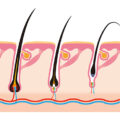Last updated on June 3, 2024
[starbox]
Hair loss is often attributed to testosterone, the male sex hormone. However, the connection between testosterone and hair growth and shedding is more complex than it seems.
Scientific research suggests that testosterone is linked to hair loss in both men and women, but the relationship is indirect and influenced by various other factors, including sensitive hair follicles, the actions of another potent hormone, and genetics.
So, how significant is testosterone’s role in hair loss? While it can get technical, we’ll keep it simple. Read on to delve into the science, treatment options, and frequently asked questions.
The Impact of Testosterone Levels on Hair Growth
Your body contains different types of testosterone but for hair growth, we’re concerned with free testosterone.
Some testosterone binds to proteins in your body, while the remaining portion is called free testosterone, which can be converted by enzymes into dihydrotestosterone (DHT)—a much more potent hormone responsible for hair growth or loss.
Studies indicate that men with baldness may have lower levels of free testosterone but higher levels of the enzyme that converts it into DHT. This suggests that increasing testosterone does not necessarily cause hair loss.
DHT contributes to the growth of pubic and body hair but also shrinks hair follicles, making it more challenging for hair to grow. Therefore, DHT plays a significant role in male and female pattern hair loss, but there are additional factors at play.
Let’s explore genetics. Your hair follicles possess receptors that interact with DHT and testosterone. The sensitivity and abundance of these receptors are determined by genetics. If you have sensitive receptors, even minimal amounts of DHT can trigger hair loss. Additionally, having more receptors increases the likelihood of experiencing hair loss.
In summary, there are four main factors contributing to hormonal hair loss:
- Sensitive hair follicles
- Higher number of receptors on the hair follicles
- Elevated levels of DHT-converting enzymes
- DHT itself
Now that we understand these factors, let’s explore approaches to tackling hormone-induced hair loss.
Treatment Options for Testosterone-Induced Hair Loss
Almost all types of hair loss, including genetic and hormonal hair loss (known as androgenetic alopecia), can be treated. The key is to address the problem as early as possible.
Cosmetic Solutions
Two popular cosmetic procedures for hair loss are:
- Follicular unit transplantation (FUT): This involves removing skin from a hairier area of the scalp, extracting follicles from the strip of skin, and transplanting them into bald spots.
- Follicular unit extraction (FUE): In this method, follicles are directly extracted from the scalp without removing any skin and transplanted to areas with hair loss.
Prescription Medication
Studies have shown that medications inhibiting the conversion of testosterone into DHT can slow down the progression of androgenetic alopecia. Finasteride is a common prescription medication that binds to enzymes, preventing them from converting testosterone into DHT.
Testosterone-Induced Hair Loss in Women
While testosterone primarily affects men, women are not immune to its effects. Women have a small amount of testosterone in their bodies, about 10 to 20 times less than men. Nevertheless, it can still contribute to androgenetic alopecia or female pattern hair loss.
DHT interacts with hair follicles in women similarly to men, although the pattern of hair loss in women differs. Women typically experience thinning over the top of the head, often noticeable through a widening part, rather than a receding front hairline.
Noticing Hair loss? Here’s what to do:
Consult a Hair Loss Doctor
As soon as you observe hair thinning, take action by scheduling a consultation with our hair loss doctor. The earlier you begin treatment, the better your chances of success. Delaying treatment may result in permanent hair loss.
Our doctors can help you identify the root cause of your balding and provide a personalised treatment plan, tailored to your needs.








